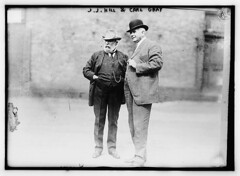The following article appeared on this blog of the RE-WIRED GROUP and was written by Douglas Crets:
What can a blog post about search vs. social network influencers turn up about shirt manufacturers and their role in consumers’ jobs-to-be-done?
Here’s a comment from a guy named Carl Mistlebauer at the Fred Wilson blog, AVC, which should show you how observing, analyzing and using data in new ways can make people and products into a success. Carl, as it turns out has done a lot of things.
The owners of an apparel manufacturer retired. They shifted their business to Carl, who decided to pursue a “size-centric” web 2.0 model for selling shirts on the Internet.
When we decided to build our first e-commerce site we did so believing that B2C would only be the “icing” on the cake, not the cake its self (that would always be retailers).The reality is that even with going into it as an after thought, and even with all the mistakes we made, we still ended up having to shut down our B2C after 6 months because we could not handle the business from an inventory standpoint (our internet efforts not only created a dramatic surge in B2C sales but it also saw a dramatic increase in our B2B sales both from new retailers interested in our product and increased sales from our existing retailers).
Something happened when Carl’s team flipped the switch on the Internet model. They got customers they didn’t know they had, or that they wanted. He had always thought that retailers were in his business model. It turns out, they were not.
Now, our traditional customer has always been a middle aged white male who is middle to working class; we also only sold pocket tees.So, then the second go at B2C we had added tee shirts and long sleeve tees. All of the sudden we started getting sales from women, younger males, and a much broader racial demographic.At this point I realized that B2C was definitely in our future and would eventually be our future (I still was not able to accept that our retailers would not account for less than 75% of our business.)
But what accounts for this shift? It turns out that knowing how a very specific kind of shopper does his or her shopping is the key.
The basic problem is that a 350 lb or 500 lb person shops differently than the mass market does. Thus the trouble with dealing with consultants and companies that provide services is that they think “t shirts” and then rely on their own experiences to come up with solutions; I would give them a whole 15 page document of information about our market, our consumer, and the psychology of the big and tall consumer and I would end up being presented what I call “a mass market plain vanilla solution.”Then a couple of years ago I found out that we were selling more big and tall tee shirts than JC Penney’s did in a year, that all I had to figure out was how to offer the big and tall consumer the same options that the mass market enjoys because first of all, none of the major players in big and tall can provide these options (Threadless, Custom Ink, Cafe Press, for example) due to their size and off shoring all production, and secondly, all I had to do was figure out how to connect with college and high school age big and tall kids (male and female) then I would be locking in their loyalty for years to come (JC Penney is attempting this with their new big and tall retail stores – but again, its brick and mortar and not consumer centric.)Then again, over the last 6 months I have visited over 15 college campuses in states with a high percentage of obese population and I realize that I need to really focus on women; that’s a whole other world for me.Right now my real struggle is with the fact that while I have a vision of what I want and where I need to head and I have coders plugging away attempting to turn my vision into reality its obvious that there is a person missing between me and them; I just cannot seem to use the right terminology or something but it sure feels that we are speaking two different languages….
Speaking two different languages. There is what the business proprietor believes the market will do, and then there is how the people in the market behave.
How do you get to the central mental and emotional core of what the individuals in that market do? Jobs-to-be-Done is one of those ways. Slow down the film. What is the person doing, thinking, feeling and wanting at the moment of choosing?
What job do they want the e-commerce site to do for them?
For Carl, it seems his customer wanted the e-commerce site to offer everything that eveyr other t-shirt provider had ever provided, but, for her.
There’s a different business in thinking that way.

No comments:
Post a Comment